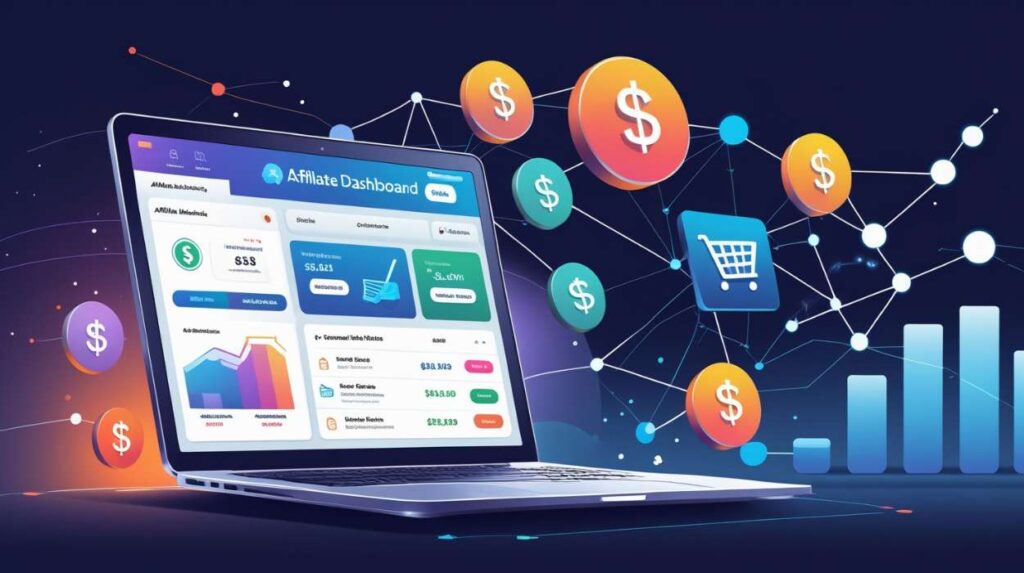Think about the last time you purchased something after a friend recommended it. Word-of-mouth marketing is very powerful because it’s based on trust. Affiliate marketing lets you tap into this kind of power, monetizing your influence and expertise by recommending products or services to your audience. It’s a win-win: businesses get new customers and you earn commissions for presenting them with a business opportunity.
What is Affiliate Marketing?
Affiliate is a performance-based marketing strategy where a business rewards one or more affiliates for each customer or1 action brought about through the affiliate’s own marketing efforts. Essentially, you become a partner with the business, promoting their offerings to your audience. You’re not an employee, but rather an independent marketer.
The main area of difference, however, exists in the importance of results rather than just placement. Businesses tend to pay the affiliates only once their marketing strategy has generated that desired action that could be something like a lead, a click, or actually a sale; thus, businesses can use affiliate marketing as cost-effective, whereas for affiliates it can be lucrative.
Why Should You Do Affiliate Marketing? Unpacking the Benefits
- Advantages: It offers several advantages that make affiliate marketing appealing to marketers and business owners.
- Low cost start-up: You do not have to worry about the product as an initial investment to set up a business from scratch. There is no need to buy quantities of inventory, rent warehouse space, and ship out the product. With time and effort, you build your audience and content.
- Flexibility and Freedom: Work from anywhere, anytime. You set your own hours and choose the projects you want to work on. This makes it ideal for those seeking location independence or a flexible side hustle.
- Potential to earn passive income: The work you put into creating content with affiliate links may take months or even years before it generates a return. For example, write a review about a product, and then after you have published it, you can continue earning commissions from it for months and years to come.
- Diversified Income Streams: You are not locked-in to only one product, company or even niche. You can diversify your income streams by working with several businesses in different niches, catering to different segments of your audience.
- No Customer Service Headache: You don’t have to deal with customer support calls, returns or refunds. The merchant will take care of all that. Your job is only to connect the customer to the product.
- Learning and Growth: Affiliate marketing is a great opportunity to learn valuable skills in digital marketing, content creation, SEO, social media marketing, and audience building. Such skills are very transferable and can be of great benefit to you in other areas of your career.
How Does Affiliate Marketing Work? A Step-by-Step Guide
Breaking the process into smaller, manageable steps would include:
Select a niche:
Use a niche that is of interest and supports a market. Be sure a selected niche represents something you are interested in or related to your line of expertise or interest, not necessarily profit-driven. Clearly defined niches provide easily targeted audiences.
Identify Affiliate Programs:
Look for a company running its affiliate programs in the niche you have chosen. Most large companies, like Amazon, eBay, and Target, offer their respective affiliate programs. There are also affiliate networks like Commission Junction (CJ Affiliate), ShareASale, and Awin. Affiliate networks connect various categories of merchants with affiliates.
Apply to Affiliate Programs:
Once you have shortlisted a couple of programs, apply to join them. In some programs, this step may vary, but generally, submitting information about your site, your audience, and marketing strategy will do.
Content Development:
You got to the fun part now. You will be creating relevant and useful content, focusing on the products or services you are promoting. It is including:
- Reviews: You must expose features, benefits, and negativities of the products.
- Tutorials: You teach people how to use a product.
- Comparison Posts: Compare different options within a specific category.
- List Posts: Recommending products from a curated list.
- Social Media Posts: Use social media for sharing your own experiences and recommended products.
- Video: Create a video review or tutorial or how-to.
Use Affiliate Links:
Insert your customized affiliate link in the content. Affiliate links have a tag while they are creating so that they can track all their traffic along with sales generated from this link.
- Distribution of Your Content: Promote your content across all networks. This includes,
- SEO: Make your content SEO-friendly in order to increase its organic traffic.
- Social Media Marketing: Distribute the content on your social media profiles and engage with the audience.
- Email Marketing: Get an email list and send the targeted promotions to the subscribers.
- Paid Advertising: Use paid advertisements on Google Ads or Facebook Ads to reach people.
How Do Affiliate Marketers Get Paid? Understanding the Payment Models
Typically, affiliate marketers earn money in one of the following ways:
- Pay Per Sale (PPS): You earn a commission for each sale generated through your affiliate link. This is the most common payment model.
- Pay Per Lead (PPL): You earn a commission for each lead you generate, such as a signup for a free trial, a newsletter subscription, or a request for a quote.
- Pay Per Click (PPC): For each click of the affiliate link, you are paid for every click made without generating any sales or leads. This is the less prevalent model since there is a risk involved on the merchant’s end.
Tips for Success in Affiliate Marketing
- Build Trust with Your Audience: Authenticity is key. Promote products you genuinely believe in and that will benefit your audience.
- Keep the focus on value: Give something that educates, entertains, or solves some problem for your audience.
- Be Patient: Affiliate marketing is not a get-rich-quick scheme. It takes time and effort to build an audience and generate consistent income.
- Stay Updated: The world of digital marketing is constantly evolving. Stay up-to-date with the latest trends and strategies.
- Track and analyze: Tracker your results and modify your strategies according to your observations.
How to Make Money as an Affiliate: A Step-by-Step Guide
Step 1: Choose Your Niche – Finding Your Niche

The first and probably the most critical step is selecting your niche. Once you come up with a few possible niches, then consider the following:
- Market Demand: Is there a large enough demand audience interested in this niche? Conduct some research to gauge the demand for products or services within your chosen area.
- Competition: How many other affiliate marketers are already running in that niche? Good competition is healthy, but too much competition is very unbearable to compete with.
- Profit Potential: Are there profitable affiliate programs in this niche? Research the commission rates and average price of products to get an idea of earning potential.
Step 2: Choose a Content Platform – Your Online Home

After you’ve selected your niche, you will need a content platform to host your content and promote your affiliate links. You have several choices, each with its pros and cons:
- Blog/Website: This is probably the most popular and promoted option for affiliate marketing. You are in full control of your content, and you can have a long-term online presence. You can give detailed reviews, tutorials, and more great resources on topics that would attract organic traffic from search engines.
- Social Media: Social media sites such as Facebook, Instagram, and YouTube can be excellent ways to promote affiliate products, particularly when you have a big following and are very active on the site.
- Email Marketing: It allows one direct access to the audience through creation of an email list from where one can mail affiliate products accompanied by targeted emails. This may be pretty effective if one tries a bit for creating the list and writing nice content in emails.
Step 3: Find Affiliate Programs to Join – Partnering with Businesses

Time to find affiliate programs to join. There are a lot of companies offering affiliate programs where you can promote their products or services for a commission. Here are some ways to find affiliate programs:
- Affiliate Networks: Affiliate networks such as Amazon Associates, CJ Affiliate, ShareASale, and Awin act as a middleman between merchants and affiliates. They have a wide variety of affiliate programs in different niches.
- Directly with Merchants: Most companies, including smaller businesses, have their own affiliate programs. You can generally find that information on the company’s site.
- Competitor Research: Look at what types of affiliate programs your competitors are using. It may give you an idea of which you may want to look into a little further for your niche.
Use the following in choosing your affiliate programs:
- Commission Rates: How much are you going to get paid for each sale or lead?
- Product Quality: Are the products or services high-quality and relevant to your audience?
- Reputation: Does the company have a good reputation?
- Payment Terms: How and when will you get paid?
Step 4: Create Great Content – The Heart of Your Strategy

Content is king in affiliate marketing. It is your content that will attract your audience, build trust, and finally get them to the sale. Thus, your goal should be high-quality informative, engaging content, which has a value to its readers. Here are some ideas for you:
- Product reviews: The products are deeply discussed, where features, advantages, and disadvantages are mentioned.
- Tutorials: Demonstrating how to use a product or service.
- Comparison Posts: Comparing different products within a category.
- List Posts: Curated lists of recommended products.
- Case studies: Using actual stories of how a product or service has made someone’s life easier.
Step 5: Drive Traffic to Your Affiliate Site – Getting the Word Out

Content creation is just one battle it will be defeated once you are able to get traffic onto your website, so people can view your content and click your affiliate links. Here are some strategies for generating traffic:
- Search Engine Optimization (SEO): Making sure that your content is optimized for search engines to generate traffic.
- Social Media Marketing: You can place your content on social media outlets and engage with audience members.
- Email marketing: It is the building of an email list and sending targeted promotions to your subscribers. Paid advertising might include use of Google Ads or Facebook Ads in trying to reach a wider audience. Guest blogging is writing guest posts for other blogs in your niche to try and get exposure.
Step 6: Get Clicks on Your Affiliate Links – Enticing Your Audience

Clicks on your affiliate links are what generate commissions. Here are some tips for increasing click-through rates:
- Place Links Strategically: Place your affiliate links within your content where they are most relevant and likely to be clicked.
- Use Clear Call-to-Actions: Make sure the call-to-actions are clear and compelling, like “Click here to learn more” or “Buy now.”
- Use Eye-Catching Banners: Use visually appealing banners to draw attention to your affiliate links.
Step 7: Convert Clicks to Sales – Closing the Deal

The ultimate goal of affiliate marketing is to convert clicks into sales. Here are some tips for improving your conversion rates:
- Build Trust: Be credible by giving them good content and being transparent about your affiliate relationship.
- Give Out Bonus: Give some exclusive bonuses that will encourage your audience to purchase through your affiliate links.
- Provide Excellent Customer Service: Answer questions and address concerns promptly.
Conclusion
Affiliate marketing can be great in terms of earning money via the internet, but it is also something that needs effort, dedication, and a proper approach to it. Follow these steps and remember to focus on providing value for your audience as you continue. Success with Affiliate partnerships does take time; don’t give up if it doesn’t happen overnight.
FAQs
1. How much money can I make as an affiliate marketer?
Your earnings depend on various factors, including your niche, traffic, and conversion rates.
2. Do I need a website to be an affiliate marketer?
While a website is recommended, you can also promote affiliate products through social media or email marketing.
3. How do I track my affiliate sales?
Affiliate programs provide tracking tools that allow you to monitor your clicks, conversions, and earnings.
4. How often do I get paid as an affiliate?
Payment terms vary depending on the affiliate program. Some programs pay monthly, while others pay quarterly.

